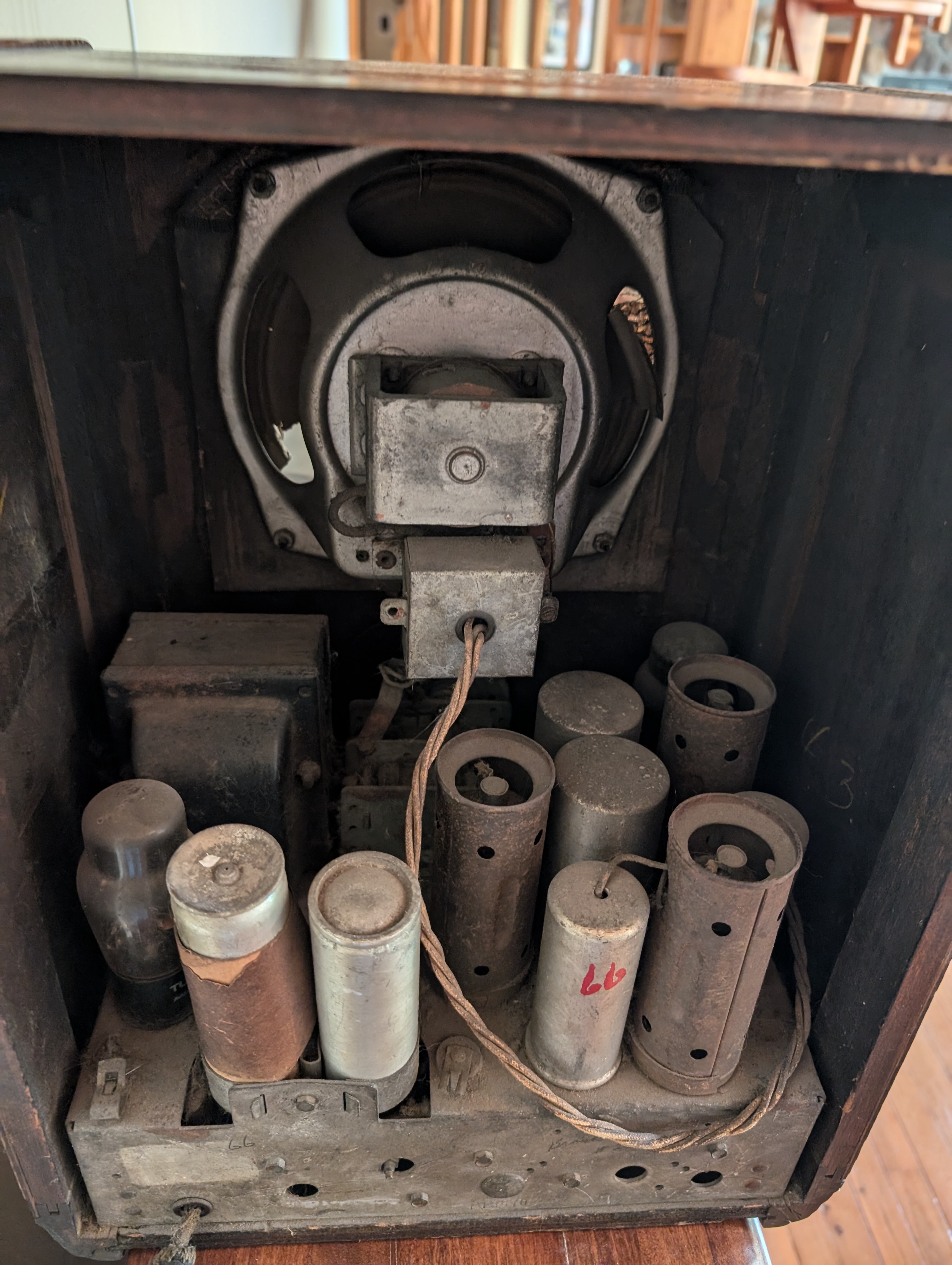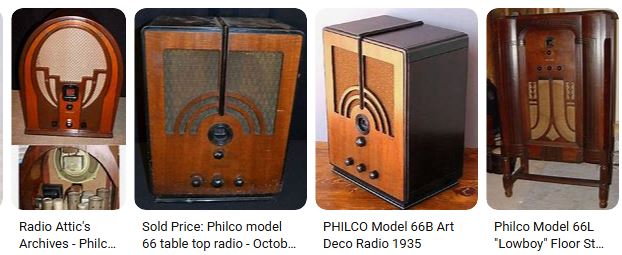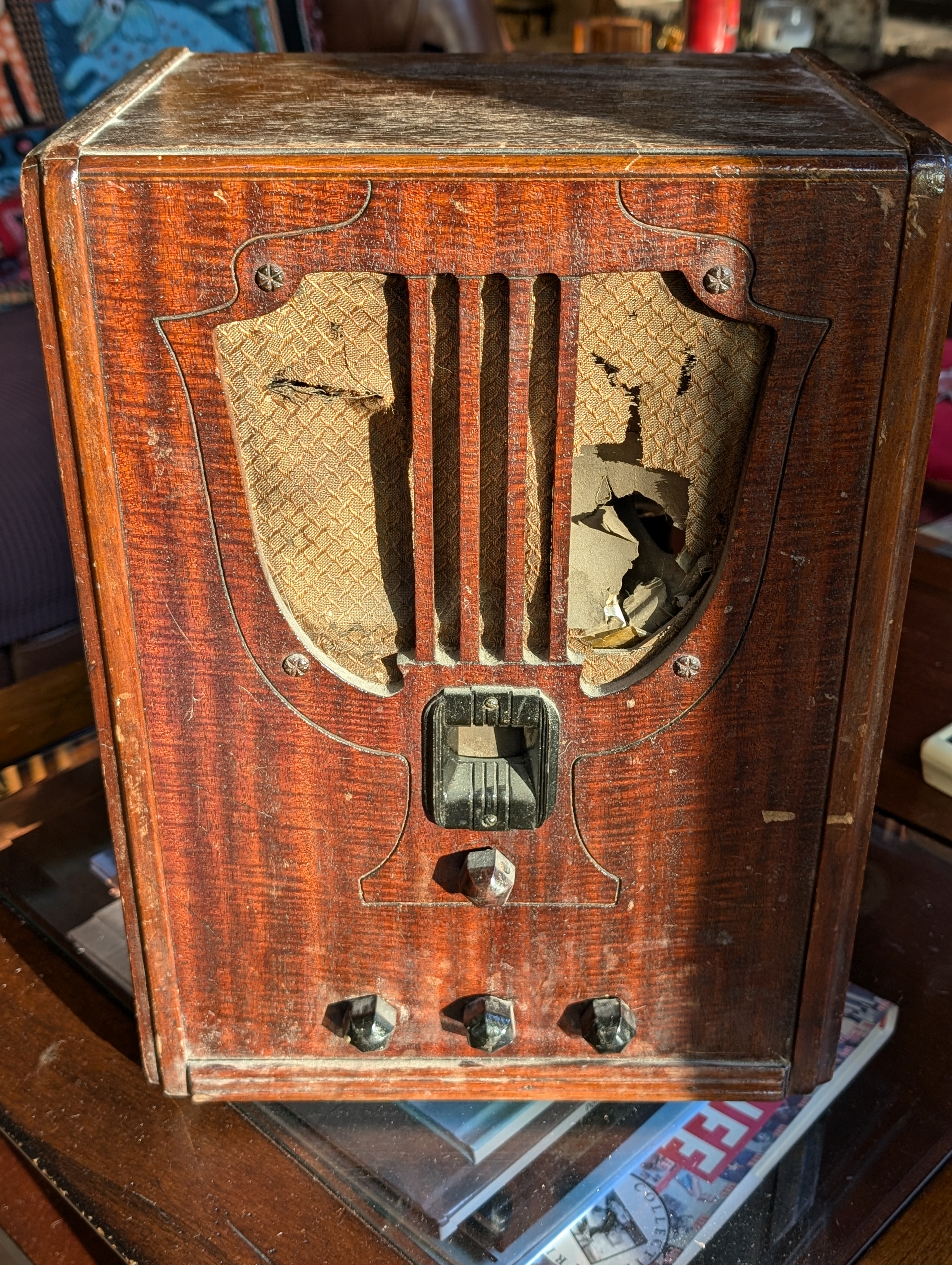Posts: 8
Threads: 2
Joined: Apr 2022
City: Lebanon
State, Province, Country: Virginia

Hey there,
TLDR; what models was this chassis in?
I brought home a new project ('35 66S) a couple days ago and I'm excited to get started on it. It's really crusty but looks to be fairly complete.
I've been looking for videos to see if anyone has documented the restoration of this set but I'm not finding much searching for "Philco 66S". I restored a Philco 37-61F a while ago and found a bunch of videos of guys restoring that chassis in different cabinets.
Is there somewhere I can research to determine what models had this same chassis (or if someone knows already).
Thanks!
Posts: 256
Threads: 15
Joined: Jan 2024
City: Tulsa
State, Province, Country: Oklahoma
Good evening! I’ve done some digging around, and it looks as though there are four models which use the 66 chassis:
1) the 1934 “early” model 66B
2) the 1934-1935 “late” model 66B
3) the 1935 model 66S
4) the 1935 model 66L
You may research (presumably) all Philco models here: https://philcoradio.com/gallery2/
Here’s the schematic for the 66 chassis: https://philcoradio.com/library/download...l.%201.pdf
Joseph
Philco 46-480
Philco 49-906
Posts: 4,861
Threads: 54
Joined: Sep 2008
City: Sandwick, BC, CA
The model 60 and 66 use a similar chassis, but the model 66 has a proper shortwave band on it whereas the model 60 has what was once the "police" band, which basically starts at the upper end of the AM broadcast band at 1.5 mc , ending at 4 mc, assuming you can read the dial.
Regards
Arran
Posts: 1,206
Threads: 11
Joined: Jul 2020
City: Greenlawn
State, Province, Country: NY
Hi KNT,
It seems that your chassis is a 66, and the schematic is available on both Nostalgia Air and in our library. Generally, if I am correct, Philco models are named after the chassis, with a suffix if the chassis appears in different cabinets (example, tabletop vs console vs chairside).
I am attaching the schematic from Nostalgia Air. The diagram is also in our library, but I am attaching the Nostalgia Air diagram because it includes a chassis top view.
BTW, Do NOT plug this unit in especially with the rectifier tube in place until you recap this unit, or at least replace the power supply filter caps. The dried material on the top of one of those caps is indicative that it was likely a "wet" electrolytic and it is likely shorted.
I did not find this in our gallery but it is listed in the chart by Ron Ramirez (God rest his good soul!) in the Philco Library > Models > Set Index
Here is a link to Radiomuseum showing 4 different models using chassis 66.
https://www.radiomuseum.org/r/philco_66.html
JRBlasde listed the models with suffixes. There is a document somewhere that explains the cabinet type denoted by the suffix. This radio was introduced in late 1933 for the 1934 and 1935 model years.
The cabinets are basically 2 types of "Baby Grand" (Cathedral or beehive style), "Moderne" (tombstone style) and "Lowboy) console style).
Pix here from an internet search:

Although this is only a 5 tube radio, it should be a good performer due to the higher B voltages than used in the AC-DC "AA5" type radios allowing higher gain in transformer powered sets. Hence, the use of this chassis in a full size console model (with the nice, bigger speaker).
It appears that your set is the 66BM "Moderne", very forward styling for the times (in the throes of the Great Depression).
"Do Justly, love Mercy and walk humbly with your God"- Micah 6:8
"Let us begin to do good"- St. Francis
Best Regards,
MrFixr55
Posts: 1,206
Threads: 11
Joined: Jul 2020
City: Greenlawn
State, Province, Country: NY
Ops, since I started and saved this several times, I did not see Arran's post stating that this is a 60 with shortwave. The 60 cabinets are shown in our gallery
"Do Justly, love Mercy and walk humbly with your God"- Micah 6:8
"Let us begin to do good"- St. Francis
Best Regards,
MrFixr55
Posts: 8
Threads: 2
Joined: Apr 2022
City: Lebanon
State, Province, Country: Virginia
Thanks for the great responses and taking the time to research.
Here's an image of the cabinet front:

Given the cabinet I'm thinking it's a 66S. I know L=Lowboy, F=Floor model but in not sure what the S represents.
Thanks for the schematics those are greatly appreciated and will come in very handy.
Here's a video of a 37-61F I restored a while ago:
[Video: https://youtu.be/IxdhvBji0eg?si=GxrnQN-AE323bwG9]
It was a gift from my son that he dug out of an old girlfriend's attic. It was terribly molested both electrically and in appearance but after a lot of learning and time I think it doesn't look terrible and it receives like a champ.
Notice the grill and the dial escutcheon on the '37 console. I haven't found many images of this combination (typically it's the black escutcheon with this grill). I wonder if that chassis was a swap.
Anyway, for the 66S I'll take a look for restoration videos of this chassis from other cabinets. If you all have any advice or tips on approaching this one I'd be happy to have the help.
Thanks again!
Posts: 2,135
Threads: 158
Joined: Jan 2013
City: Westland, MI
It does appear to be a 66S, which, according to Ron's book, housed a 60 chassis. It's an early example based on the eschutcheon used. Kind of a rare set - only 13,000 were built. Our gallery has a picture of what your set could be with a little TLC.
https://philcoradio.com/gallery2/1935c/
Take care and BE HEALTHY! Gary
"Don't pity the dead, pity the living, above all, those living without love."
Professor Albus Dumbledore
Gary - Westland Michigan
Posts: 8
Threads: 2
Joined: Apr 2022
City: Lebanon
State, Province, Country: Virginia
Thanks Gary,
I've seen some really nice examples with two colors of toner. I think I'd like to get this one more true to original on the cabinet. The 37-66 was pretty much destroyed so I didn't feel bad about the finish on that one.
Can't wait to get started!
Posts: 7,295
Threads: 268
Joined: Dec 2009
City: Roslyn Pa
Three things about the 60 vs the 66. Both chassis look the same from the top. From the bottom there's a big difference. The 66 has a phenolic board that a bunch of parts are soldered to, not so on the 60. The 66 SW band goes from 5-16mc or so. Only clean the dial w/mineral spirits else the print will rub off.
https://philcoradio.com/library/download...%20197.pdf
When my pals were reading comic books
I was down in the basement in my dad's
workshop. Perusing his Sam's Photofoacts
Vol 1-50 admiring the old set and trying to
figure out what all those squiggly meant.
Circa 1966
Now I think I've got!
Terry
(This post was last modified: 10-27-2024, 02:38 PM by Radioroslyn.)
Posts: 1,206
Threads: 11
Joined: Jul 2020
City: Greenlawn
State, Province, Country: NY
Nice job on the 37-61!     Even the RCA Victor Dog seems to like it.
Thx for the pic of the front of your set, I should have scanned down on the page when I did not see it on the thumbnail. it is obviously NOT the Moderne but will be very nice when you are done. Right off the bat, just cleaning it and replacing the grille cloth would make it presentable, but based on your 37-61, I think you are going for more.
The chassis on this set and your 37-61 are similar electronically, except that the 37-61 uses the newer generation of octal tubes and the SW band. So, other than the speaker size, which, along with the cabinet size, gave that nice boomy bass on that great big band music, you should expect similar reception.
How you restore this depends on what you are looking for. Restoration would be similar to your 37-61. At the very least, do what you likely did with your other radios:
Replace all capacitors! The filter caps and all of the paper caps that are embedded in the bakelite blocks. There are several articles on the Phorum on how to empty these blocks easily. I use the technique of cutting the wires to the internal parts of the block and using sheet metal screws to jack out the tar. It is not necessary to refill the blocks with tar after the caps are replaced. It may even be possible to replace these caps without having to remove the wiring from the blocks. For the 2 caps across the primary of the power transformer to suppress power line noise, replace these with type Y safety caps. The originals tend to short.
Measure all resistors and replace any that are more than 20% different than the listed value. Ohm out all coils.
Your speaker is obviously damaged. Choices include reconing (Others on the Phorum have either done themselves or dent out to a service), finding a replacement on eBay (8" speaker with an 1140 Ohm (+/- 20%) field coil and an output transformer to match to a type 42 or 6F6 tube will do) or (temporarily?) replacing with a modern 8" speaker an 1140 Ohm resistor and higher capacity filter caps. The Philco Library has a list of speakers, their Philo P/Ns, size, field coil impedance, type of output tube used and what models used the speaker.
The wiring should be in good shape unless the insulation is rubber and deteriorated. This can be dealt with either by cutting one end and sliding heat shrink tubing over the wire, or completely rewiring.
There are several ways to deal with the corrosion on the chassis. Don't inhale if sanding because the chassis may be cadmium plated. I use Navel Jelly on the rusty areas and either soapy water or window cleaner, depending on the type of dirt. However, seek the advice of others on the Phorum who have done totally unbelievable jobs by removing all components and acid treating and plating the chassis to original (or better!).
Be careful cleaning the dial. The wrong technique will remove the printing. Replacement dials are available from several small businesses that cater to this hobby.
There are several techniques for cleaning the tuning capacitor. Some folks have removed the tuning cap and put in the dishwasher or an ultrasonic cleaner. I have not tried this.
Hope this helps!
"Do Justly, love Mercy and walk humbly with your God"- Micah 6:8
"Let us begin to do good"- St. Francis
Best Regards,
MrFixr55
Posts: 8
Threads: 2
Joined: Apr 2022
City: Lebanon
State, Province, Country: Virginia
Thanks for the tips guys!
I'll keep an eye out for the phenolic board. Assuming it's turret board and not early PCB. I still have nightmares about peeling traces on a late 40s Motorola "PlaCir" board. ?
Thanks for the compliments on the 37-61F MrFixr. It was a labor of love and was a great learning experience. I sourced grill cloth and the radio dial for it from RadioDaze. I'm hoping they'll have the same for this one.
Re: bakelite blocks, I re-stuffed the ones in the 37 and found it strangely satisfying. I used a heat shrink wrap heat gun but I'll try the screw method on one and see how it goes.
The only thing I haven't attempted is a speaker re-cone but I think I'd like to give it a shot. Any tips would be welcome.
I've got a '46 RCA Victor Globe Trotter on the bench right now but I can't wait to get started on the Philco. I think the RCA is getting a little jealous.
Posts: 2,135
Threads: 158
Joined: Jan 2013
City: Westland, MI
You might want to contact Micheal Katz. He is an excellent source for vintage replication cloth, and a great guy to do business with. His #17 pattern is almost identical.
https://www.radiogrillecloth.com/
Take care and BE HEALTHY! Gary
"Don't pity the dead, pity the living, above all, those living without love."
Professor Albus Dumbledore
Gary - Westland Michigan
Posts: 16,476
Threads: 573
Joined: Oct 2011
City: Jackson
State, Province, Country: NJ
This is my thread, from a few years ago.
See if there anything useful.
https://philcoradio.com/phorum/showthrea...ghlight=66
People who do not drink, do not smoke, do not eat red meat will one day feel really stupid lying there and dying from nothing.
Posts: 8
Threads: 2
Joined: Apr 2022
City: Lebanon
State, Province, Country: Virginia
Thanks for the link Morzh. Just having the info about the schematic error will likely save me some grief!
Posts: 16,476
Threads: 573
Joined: Oct 2011
City: Jackson
State, Province, Country: NJ
Yeah, 66 and 60 are known to that.
I forgot what I wrote, but if I were to guess, it is that missing tie-dot from one of the plate resistors to the power/electrolytic capacitor.
People who do not drink, do not smoke, do not eat red meat will one day feel really stupid lying there and dying from nothing.
Users browsing this thread: 1 Guest(s)
|
|
Recent Posts
|
|
Need to purchase some accessories for restoration of my Old Philco Radio
|
| Here is a list of resources found in our online library that you might find useful. Mike's Gobs of Knobs email addres...klondike98 — 01:46 PM |
|
First Radio restoration
|
| Hi Tubeman,
Welcome to the Philco Phorum. Phamily Phriendly Pfun with Phine Pholks Phull of Philco Phacts. (See a p...MrFixr55 — 12:33 PM |
|
First Radio restoration
|
| You could post in the WANTED ADs section here on the Phorum and see if anyone has an RF generator that they want to sell...klondike98 — 11:55 AM |
|
Zenith H725
|
| Good ideas, thank you Arrange and Rich. I have the adhesive aluminum foil already and can try that immediately.
More ...EdHolland — 10:18 AM |
|
Graphics for majestic 1050 dial glass.
|
| Murf;
I found this thread on the ARF, the first photo has a pretty good view of the dial glass.
Regards
ArranArran — 01:12 AM |
|
Zenith H725
|
| hello Ed,
how about that speacial tape used for ducting it's like foil or how about thin piece of
aluminum roof flash...radiorich — 12:19 AM |
|
Zenith H725
|
| Ed;
One material that I have seen, but never tried for this was material for making exhaust gaskets, it's similar to ...Arran — 11:42 PM |
|
Zenith H725
|
| I just remembered, I have some hi temp silicone rubber material which could do the trick. Or a piece of FR4 laminate. Th...EdHolland — 08:39 PM |
|
Zenith H725
|
| The PSU filter cap arrived today (thank you USPS!) so I will work on that later.
Meanwhile, I have the dial, speaker...EdHolland — 06:42 PM |
|
Philco 610B oscillator wiring
|
| Thanks Terry. After checking my notes I think I recorded about -10v at the 6A7 G4/control grid. The screen grid (G3 &...Tubester — 05:59 PM |
|
Who's Online
|
| There are currently no members online. |

|
 
|




![[-] [-]](https://philcoradio.com/phorum/images/bootbb/collapse.png)


